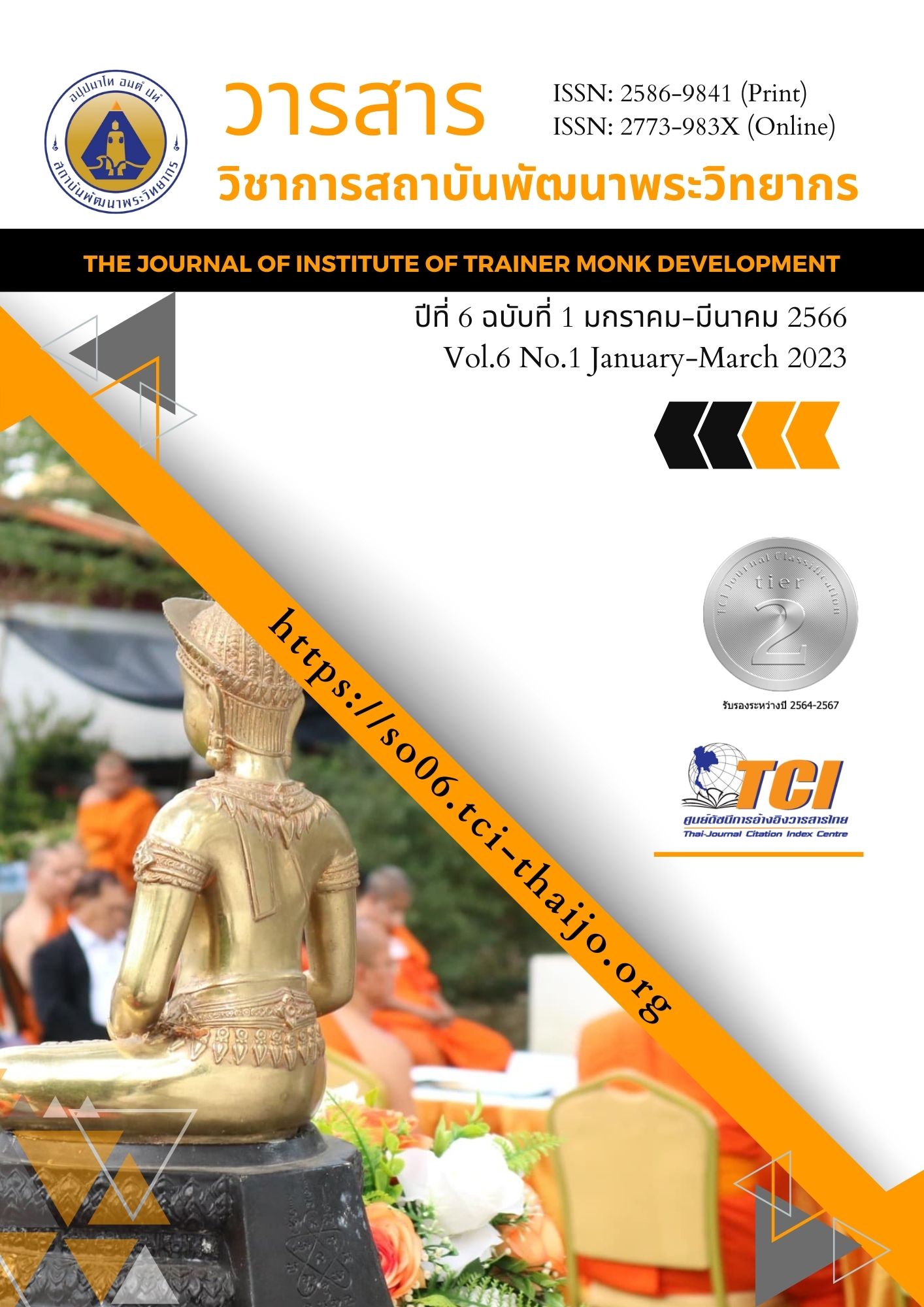An Analytical Study of the Buddha's Teaching in Dvaravati Buddhist Art
Main Article Content
Abstract
The purpose of this research was to study Buddhist art in Buddhism. A study of the dharma principles that appeared in Buddhist art in the Dvaravati period. and analyzing the importance of the dharma principles that appear in Buddhist art. It is qualitative research and documentary research. The results showed that: 1. The study of Buddhist art in Buddhism Buddhist art in Buddhism, Buddha images, architecture, Thawornwathu, stone, and various paintings reflect the value of Buddhist art reflecting cultural identity. Traditions and values that are unique to Buddhism. 2. The dharma principles in Dvaravati era Buddhist art, such as the Dhammachakkappavattanasutra; operate the middle line Steps, guidelines for making the opinions into practice for knowledge, for the elimination of suffering, Buddhist symbols, remembering this noble principle and introducing it into practice. Considering the Four Noble Truths and the Eightfold Path, the trinity is the path leading to the cessation of suffering. complete absence of suffering is the ultimate goal of Buddhism, symbolizing liberation or nirvana 3. Analyze the importance of the Dhamma principles that appear in Buddhist art. The most important doctrine is the Four Noble Truths, the Eightfold Path. Patitcasamuppada has the twelve bodies and the trinity, the dharma values that are the cornerstones of culture, appear firmly in the minds of the Thai people in order to train the young guides to participate in the dissemination of the hidden Buddhist principles. In Buddhist art, promoting tourism to the folk museum.
Article Details

This work is licensed under a Creative Commons Attribution-NonCommercial-NoDerivatives 4.0 International License.
บทความที่ได้รับการตีพิมพ์เป็นลิขสิทธิ์ของวารสารวิชาการสถาบันพัฒนาพระวิทยากร
ข้อความที่ปรากฎอยู่ในบทความที่ได้รับการตีพิมพ์ในวารสาร ถือเป็นความรับผิดชอบของผู้เขียนบทความ และข้อคิดเห็นนั้นไม่ถือว่าเป็นทัศนะและความรับผิดชอบของกองบรรณาธิการวารสารวิชาการสถาบันพัฒนาพระวิทยากร
References
สมพงษ์ สันติสุขวันต์. (2550). การศึกษาวิเคราะห์ประวัติศาสตร์พระพุทธศาสนาในสมัยทวารวดี. วิทยานิพนธ์พุทธศาสตรมหาบัณฑิต. บัณฑิตวิทยาลัย: มหาวิทยาลัยมหาจุฬาลงกรณราชวิทยาลัย.
สมบูรณ์ ดำดี. (2549). การศึกษาปรัชญาในงานพุทธศิลป์เพื่อเป็นแนวทางการออกแบบตกแต่งภายในพิพิธภัณฑ์พุทธศิลป์. วิทยานิพนธ์ศิลปะมหาบัณฑิต. บัณฑิตวิทยาลัย: มหาวิทยาลัยศิลปากร.
ไตรภพ สุทธเขต. (2552). การสืบทอดพุทธศิลป์ล้านนากรณีศึกษา:วัดแสนเมืองมาหลวง(หัวข่วง) จ.เชียงใหม่. วิทยานิพนธ์พุทธศาสตรมหาบัณทิต. บัณฑิตวิยาลัย: มหาวิทยาลัยมหาจุฬาลงกรณราชวิทยาลัย.
สุภัทรดิศ ดิศกุล. (2534). ศิลปอินเดีย. กรุงเทพฯ: มหาวิทยาลัยศิลปากร.
ธีรพงษ์ มีไธสง และพระมหาอุดร สุทฺธิญาโณ. (2560) ธรรมจักรในพระพุทธศาสนาเถรวาท. วารสาร มจร. บาฬีศึกษาพุทธโฆสปริทรรศ 3(2), 103-119.
สมเกียรติ โล่เพชรัตน์. (2546). วิเคราะห์ประวัติการนับถือศาสนาพุทธและศิลปะพระพระพุทธศาสนาในเอเซีย. กรุงเทพมหานคร: อมรินทร์พริ้นติ้งแอนพับลิชชิ่ง.
ศักดิ์ชัย สายสิงห์. (2562). ศิลปะทวารวดี วัฒนธรรมทางศาสนายุคแรกเริ่มในดินแดนไทย. พิมพ์ครั้งที่ 2 (ฉบับปรับปรุงใหม่). นนทบุรี: สำนักพิมพ์เมืองโบราณ.
อนุพงษ์ ดาวทอง, (2560). อัตลักษณ์พุทธศิลปกรรมในจังหวัดเชียงราม. วิทยานิพนธ์พุทธศาสนตร มหาบัณฑิต. บัณฑิตวิทยาลัย: มหาวิทยาลัยจุฬาลงกรณราชวิทยาลัย.
ธิดา สาระยา. (2536). (ศรี) ทวารวดี ประวัติศาสสตร์ยุคต้นของสยามประเทศ. กรุงเทพมหานคร:สำนักพิมพ์ด่านสุทธาการพิมพ์.


